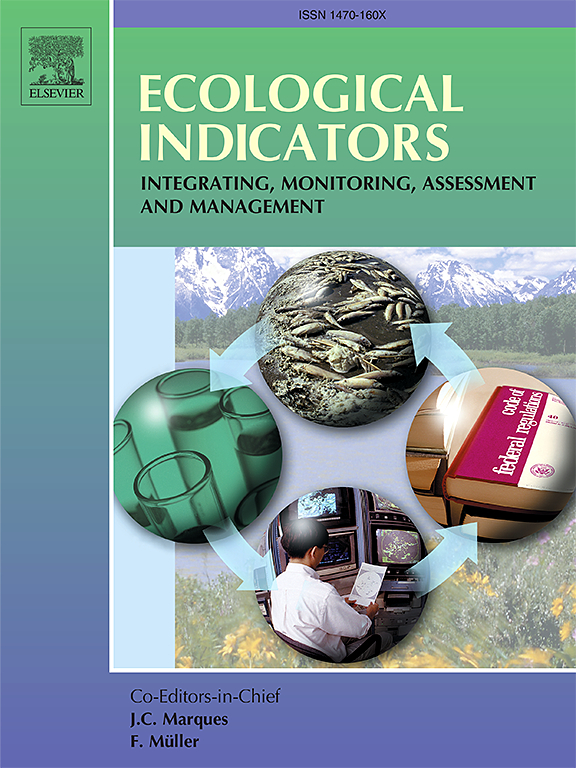Evaluating dynamics of water yield and its driving forces in the Taihang Mountain Region, China
IF 7
2区 环境科学与生态学
Q1 ENVIRONMENTAL SCIENCES
引用次数: 0
Abstract
Water yield (WY) is a critical indicator of water availability, playing a significant role in sustaining ecosystem stability. Understanding the factors influencing water yield is crucial for effective regional water resource management and the long-term sustainability of ecosystems. However, the dynamics of water yield and the driving mechanisms in the Taihang Mountain Region (TMR), particularly the influence of extreme precipitation, remain insufficiently understood. In this study, we employed the InVEST model to analyze water yield dynamics across the TMR. We introduced an analytical framework that integrates detrending analysis with scenario-based simulation to investigate the contributions of climate change (CC) and land use and land cover change (LUCC) to water yield. Furthermore, we applied the optimal parameters-based geographical detector (OPGD) to examine the influence of precipitation characteristics on water yield. We found that water yield in the TMR exhibited a decreasing trend of −0.66 mm/yr from 1990 to 2020. Significant spatial heterogeneity was observed in water yield changes, with notable decreases predominantly distributed in the eastern slope of the TMR. CC and LUCC contributed 86.46 % and 13.54 % to water yield variation, respectively. Our findings revealed that changes in water yield in the TMR are strongly influenced by precipitation patterns, with precipitation trends and extreme precipitation serving as the primary drivers. Notably, in areas experiencing significant water yield decline, precipitation intensity plays a more dominant role than precipitation trends. Afforestation areas exhibited a significantly higher decline in water yield than non-afforestation regions from 1990 to 2020. These findings provide valuable insights for guiding afforestation projects in TMR.
太行山区产水量动态及其驱动力评价
水分产量是水资源有效性的重要指标,对维持生态系统的稳定起着重要作用。了解影响水量的因素对有效的区域水资源管理和生态系统的长期可持续性至关重要。然而,太行山地区的产水量动态及其驱动机制,特别是极端降水的影响尚不清楚。在本研究中,我们采用InVEST模型分析了整个TMR的产水量动态。本文引入趋势分析与情景模拟相结合的分析框架,探讨了气候变化(CC)和土地利用与土地覆盖变化(LUCC)对产水量的影响。此外,我们应用基于最优参数的地理探测器(OPGD)研究降水特征对水量的影响。结果表明,从1990年到2020年,TMR的产水量呈- 0.66 mm/yr的下降趋势。产水量变化具有显著的空间异质性,显著的减少主要分布在TMR的东坡。CC和LUCC对产水量变化的贡献率分别为86.46%和13.54%。研究结果表明,TMR水量变化受降水模式的强烈影响,其中降水趋势和极端降水是主要驱动因素。值得注意的是,在产水量显著下降的地区,降水强度的主导作用大于降水趋势。1990 ~ 2020年造林区产水量降幅显著高于非造林区。这些发现为指导TMR造林项目提供了有价值的见解。
本文章由计算机程序翻译,如有差异,请以英文原文为准。
求助全文
约1分钟内获得全文
求助全文
来源期刊

Ecological Indicators
环境科学-环境科学
CiteScore
11.80
自引率
8.70%
发文量
1163
审稿时长
78 days
期刊介绍:
The ultimate aim of Ecological Indicators is to integrate the monitoring and assessment of ecological and environmental indicators with management practices. The journal provides a forum for the discussion of the applied scientific development and review of traditional indicator approaches as well as for theoretical, modelling and quantitative applications such as index development. Research into the following areas will be published.
• All aspects of ecological and environmental indicators and indices.
• New indicators, and new approaches and methods for indicator development, testing and use.
• Development and modelling of indices, e.g. application of indicator suites across multiple scales and resources.
• Analysis and research of resource, system- and scale-specific indicators.
• Methods for integration of social and other valuation metrics for the production of scientifically rigorous and politically-relevant assessments using indicator-based monitoring and assessment programs.
• How research indicators can be transformed into direct application for management purposes.
• Broader assessment objectives and methods, e.g. biodiversity, biological integrity, and sustainability, through the use of indicators.
• Resource-specific indicators such as landscape, agroecosystems, forests, wetlands, etc.
 求助内容:
求助内容: 应助结果提醒方式:
应助结果提醒方式:


